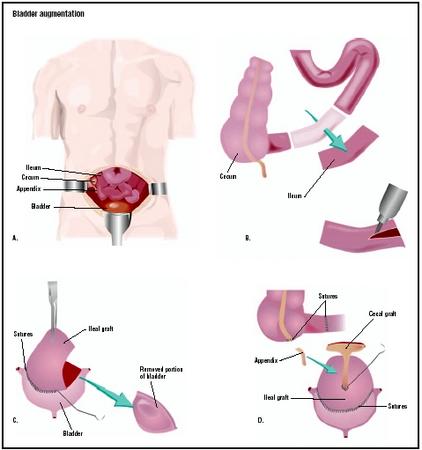How Spina Bifida affects Your Bladder?
Spina Bifida (SB) is a collective term that refers to any birth defect due to incomplete closure of the spinal column. Most often, this congenital malformation occurs in the first 4 weeks of pregnancy. In more than 90% of the cases the nerve supply and functionality of the bladder is impaired. This impaired signal also results in abnormal sphincter muscle function. Sometimes, the spinal cord damage is partial and some signals pass through the nerves to reach the bladder. This allows for the possibility of catheterisation for the emptying the bladder. This method is a useful and safer procedure for a more independent life. Some SB patients are born without any damage to their bladder, but with the passage of time the severity of paralysis increases leading to a neurogenic bladder (a condition in which person loses the bladder control). It is also called spina bifida bladder control. In spina bifida bladder control, the patient may have partial or complete loss of voluntary urination.
Management of bladder incontinence caused by spina bifida
Bladder Augmentation (BA)
BA is a surgical change in the urinary bladder where small parts of tissues are removed from the intestinal tract and are implanted into the tissues of the bladder. Bladder augmentation with gastrointestinal tissue is a well known procedure in urology for the management of urinary incontinency due to Spina Bifida. This procedure preserves the upper urinary tract and reconstructs the spina bifida malformation. The purpose of bladder augmentation is to create a path for sufficient functional capacity with low filling pressure.

When the procedure is done, the filling pressure does not interrupt the ureteral delivery of urine to the bladder and the upper urinary tract remains safe [1]. Sometimes, BA does not work due to retention problems. Such cases are then managed through spina bifida bladder control with clean intermittent catheterization (CIC). After CIC, BA can be performed with segments from the stomach [2], small bowl [3], large bowl or maybe the ureter [4]. Some medicines can also help the patients with bladder incontinence such as ditropan which relaxes the muscles so that more urine is stored; however, keep in mind that excessive use of these drugs can cause dehydration and constipation.
Complications due to BA in patients of Spina bifida
1. Metabolic Complications
Binding of the intestine with the urinary tract may produce metabolic changes by interruption in the absorption of bowl contents. Because of direct exposure with urine, ileum or colon may absorb ammonium and chloride ions which can cause hyperchloremic metabolic acidosis [5].
2. Reoperation
BA is a major surgical procedure that is performed under general anaesthesia which has its own complications that cannot be easily tolerated by the SB patient. Recently, it has been reported that the reoperation rate of BA related procedures is more than 34% [6].
3. Bladder Perforation
This is one of the life-threatening complications that occur to the patients who have already been operated on for BA. The patient presents with the history of abdominal pain and BA. The frequency of this complication varies from one group to another group. Spina bifida may also lead to peritonitis and severe abdominal pain.
4. Bowel Obstruction
Bowel obstruction is an uncommon complication for the patients of BA. Its incidence has been reported as 2-6% [6,7]. This complication is 7-8 times more common in gastric augmentation as compared to other procedures.
5. Bladder Stones
“Bladder stones” is a common problem after BA in SB patients. Most of time, it occurs due to the lack of mucus production and sometimes due to the bacterial interruption. To avoid these complications, a yearly ultrasound scan should be performed. If stones are diagnosed they should be treated conservatively at first. However, surgical procedures may be performed when required.
6. Bladder cancer
Of all the cases with BA, the most dangerous complication among the patients of SB is bladder cancer. This complication is associated with every type of BA (with stomach, small bowel, large bowel, colon or ileum).
[ois skin=”1″]
Refrences
- Simon J. Extropia vesicae (absence of the anterior walls of the bladder and rubic abdominal parietes): Operation for directing the orifices of the ureters into the rectum: Temporary success: Subsequent death. autopsy. Lancet. 1852;2:568.
- Winter CC, Goodwin WE. Results of sigmoidocystoplasty. J Urol. 1958;80:467-72.
- Goodwin WE, Winter CC, Baker WF. Cup-patch technique of ileocystoplasty for bladder enlargement or partial substitution. Surg Gynecol Obstet. 1959;108:240-4.
- Dewan PA, Anderson P. Ureterocystoplasty: The latest developments. BJU Int. 2001;88:744-51.
- Koch M, McDougal W, Thompson C. Mechanisms of solute transport following urinary diversion through intestinal segments: an experimental study with rats. J Urol 1991; 146:1390-97.
- Metcalf P, Cain M, Kaefer M, et al. What is the need for additional bladder surgery after bladder augmentation in childhood? J Urol 2006; 176:1801-5.
- Sherkarriz B, Upadhyay J, Demirbilek S, et al. Surgical complications of bladder augmentation: comparison between various enterocystoplasties in 133 patients. Urology 2000; 55:123-8.
Related Articles:
- 5 Facts about Neurogenic Bladder Treatment
- Spina Bifida Urolithiasis, Kidney Stones, Urinary Tract Stones & etc
- 10 Ways to Manage Spina Bifida Back Pain
- 15 Health Care Issues for Adults living with Spina Bifida
- 6 Disorders Associated with Spina Bifida
- Lordosis: Causes, Symptoms, Diagnosis, Treatment & Exercises
- Occupational & Physical Therapy Treatment for Spina Bifida


